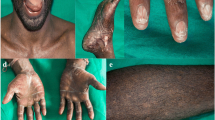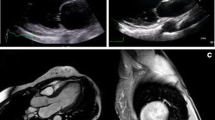Abstract
Hoyeraal-Hreidarsson syndrome represents a severe variant of dyskeratosis congenita (Zinsser-Cole-Engman syndrome). This X-linked recessive, progressive, multisystemic disorder reported so far in 12 pedigrees is characterised by intrauterine growth retardation, microcephaly, cerebellar hypoplasia, mental retardation, progressive combined immune deficiency and aplastic anaemia. Mutations in the DKC1gene on Xq28 have been identified in the X-linked form of dyskeratosis congenita and in some Hoyeraal-Hreidarsson syndrome patients. We report on two sibs and two other unrelated patients with the striking clinical features of Hoyeraal-Hreidarsson syndrome. Noticeably, all four had early digestive problems, with chronic, bloody diarrhoea and feeding problems causing one of the most difficult problems in the supportive treatment of this uniformly lethal condition. Pathological changes in the proliferative compartment of the digestive mucosa included alterations of the glandular architecture and focal rarefaction of the glands. This aspect seems consistent with altered telomerase function associated with a dyskerin mutation which may decrease the proliferative capacity of digestive epithelial cells. A missense mutation 146 C→T (Thr49Met) in the DKC1gene was found in two unrelated patients, whereas mutation screening was negative for one single case. The absence of mutations of the DKC1gene in patients with Hoyeraal-Hreidarsson syndrome emphasises the probable implication of one or more other loci.


Similar content being viewed by others
Abbreviations
- DC :
-
dyskeratosis congenita syndrome
- HH :
-
Hoyeraal-Hreidarsson syndrome
- IUGR :
-
intrauterine growth retardation
References
Aalfs CM, van den BH, Barth PG, Hennekam RC (1995) The Hoyeraal-Hreidarsson syndrome: the fourth case of a separate entity with prenatal growth retardation, progressive pancytopenia and cerebellar hypoplasia. Eur J Pediatr 154: 304–308
Berthet F, Tuchschmid P, Boltshauser E, Seger RA (1995) The Hoyeraal-Hreidarsson syndrome: don’t forget the associated immunodeficiency. Eur J Pediatr 154: 998
Collins K, Mitchell JR (2002) Telomerase in the human organism. Oncogene 21: 564–579
Connor JM, Gatherer D, Gray FC, Pirrit LA, Affara NA (1986) Assignment of the gene for dyskeratosis congenita to Xq28. Hum Genet 72: 348–351
Cossu F, Vulliamy TJ, Marrone A, Badiali M, Cao A, Dokal I (2002) A novel DKC1 mutation, severe combined immunodeficiency (T+B-NK- SCID) and bone marrow transplantation in an infant with Hoyeraal-Hreidarsson syndrome. Br J Haematol 119: 765–768
Dokal I (2001) Dyskeratosis congenita. A disease of premature ageing. Lancet 358[Suppl]: S27
Heiss NS, Megarbane A, Klauck SM, Kreuz FR, Makhoul E, Majewski F, Poustka A (2001) One novel and two recurrent missense DKC1 mutations in patients with dyskeratosis congenita (DKC). Genet Couns 12: 129–136
Hoyeraal HM, Lamvik J, Moe PJ (1970) Congenital hypoplastic thrombocytopenia and cerebral malformations in two brothers. Acta Paediatr Scand 59: 185–191
Hreidarsson S, Kristjansson K, Johannesson G, Johannsson JH (1988) A syndrome of progressive pancytopenia with microcephaly, cerebellar hypoplasia and growth failure. Acta Paediatr Scand 77: 773–775
Knight SW, Heiss NS, Vulliamy TJ, Aalfs CM, McMahon C, Richmond P, Jones A, Hennekam RC, Poustka A, Mason PJ, Dokal I (1999) Unexplained aplastic anaemia, immunodeficiency, and cerebellar hypoplasia (Hoyeraal-Hreidarsson syndrome) due to mutations in the dyskeratosis congenita gene, DKC1. Br J Haematol 107: 335–339
Mahmood F, King MD, Smyth OP, Farrell MA (1998) Familial cerebellar hypoplasia and pancytopenia without chromosomal breakages. Neuropediatrics 29: 302–306
Montanaro L, Chilla A, Trere D, Pession A, Govoni M, Tazzari PL, Derenzini M (2002) Increased mortality rate and not impaired ribosomal biogenesis is responsible for proliferative defect in dyskeratosis congenita cell lines. J Invest Dermatol 118: 193–198
Nespoli L, Lascari C, Maccario R, Nosetti L, Broggi U, Locatelli F, Binda S, Gaudio F, Casalone R, Bosi F (1997) The Hoyeraal-Hreidarsson syndrome: the presentation of the seventh case. Eur J Pediatr 156: 818–820
Nobili B, Rossi G, De Stefano P, Zecca M, Giorgiani G, Perrotta S, Canazzio A, Locatelli F (2002) Successful umbilical cord blood transplantation in a child with dyskeratosis congenita after a fludarabine-based reduced-intensity conditioning regimen. Br J Haematol 119: 573–574
Ohga S, Kai T, Honda K, Nakayama H, Inamitsu T, Ueda K (1997) What are the essential symptoms in the Hoyeraal-Hreidarsson syndrome? Eur J Pediatr 156: 80–81
Solder B, Weiss M, Jager A, Belohradsky BH (1998) Dyskeratosis congenita: multisystemic disorder with special consideration of immunologic aspects. A review of the literature. Clin Pediatr (Phila) 37: 521–530
Vulliamy T, Marrone A, Dokal I, Mason PJ (2002) Association between aplastic anaemia and mutations in telomerase RNA. Lancet 359: 2168–2170
Vulliamy T, Marrone A, Goldman F, Dearlove A, Bessler M, Mason PJ, Dokal I (2001) The RNA component of telomerase is mutated in autosomal dominant dyskeratosis congenita. Nature 413: 432–435
Vulliamy TJ, Knight SW, Mason PJ, Dokal I (2001) Very short telomeres in the peripheral blood of patients with X-linked and autosomal dyskeratosis congenita. Blood Cells Mol Dis 27: 353–357
Womer R, Clark JE, Wood P, Sabio H, Kelly TE (1983) Dyskeratosis congenita: two examples of this multisystem disorder. Pediatrics 71: 603–609
Yaghmai R, Kimyai-Asadi A, Rostamiani K, Heiss NS, Poustka A, Eyaid W, Bodurtha J, Nousari HC, Hamosh A, Metzenberg A (2000) Overlap of dyskeratosis congenita with the Hoyeraal-Hreidarsson syndrome. J Pediatr 136: 390–393
Author information
Authors and Affiliations
Corresponding author
Rights and permissions
About this article
Cite this article
Sznajer, Y., Baumann, C., David, A. et al. Further delineation of the congenital form of X-linked dyskeratosis congenita (Hoyeraal-Hreidarsson syndrome). Eur J Pediatr 162, 863–867 (2003). https://doi.org/10.1007/s00431-003-1317-5
Received:
Accepted:
Published:
Issue Date:
DOI: https://doi.org/10.1007/s00431-003-1317-5




